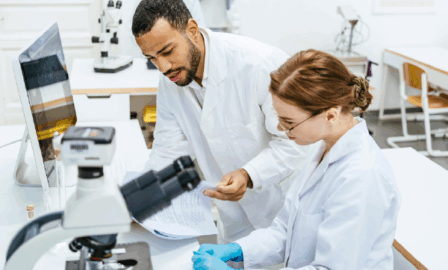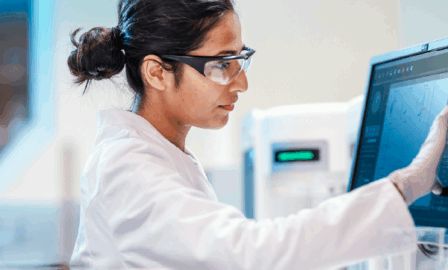2024 Laboratory Trends
Clarkston’s team of life sciences consultants have highlighted the top laboratory trends that businesses should consider. Read all 4 trends for 2024 by downloading the full report here.
The life science industry is currently in “Industry 4.0,” meaning the use of advancements such as automation, artificial intelligence (AI), machine learning (ML), and data analytics, is expansive and growing. The reason for this categorization is the significant impact these innovative tools can make, especially within life sciences labs.
Many labs have increasingly started to utilize more technology, and for those that haven’t, they likely plan to in the next one to two years. The opportunities labs have to take advantage of these up-and-coming tools are vast. Automation, AI/ML, and data analytics can reduce simple, repetitive, and time-consuming tasks so labs can focus on high-quality, groundbreaking results. While there are many benefits to leveraging technological advancements within labs, concerns over data privacy, ethical principles, and federal regulations must be considered.
2024 Laboratory Trends
Trend #1: Leveraging Automation for Lab Operations
Almost every company values efficiency and effectiveness in their operations, and there are many tools that can assist in creating this reality. Automation has evolved to become a key asset for many labs. A main benefit is automation doesn’t require constant human supervision. Labs that have leveraged automation don’t have to worry as much about staffing issues and labor costs when they have machines to do tasks for them.
Automation can perform simple tasks such as pre- and post-analytic steps like barcoding, re/de-capping, sorting, etc. This reduces human error and significantly increases productivity. Automation allows lab technicians to focus on more complex work, resulting in faster turnaround times. Automation will continue to be added to and evolve in labs to make the most positive use of its capabilities. These capabilities “precisely and accurately conduct routine tasks… which is especially helpful for high-throughput screening and next-generation sequencing experiments.” It’s predicted the global market for Modular Laboratory Automation will reach a revised size of US$5.7 Billion by 2030.
If labs are cautious about using automation, they can start slow by using partial automation, which is automating one repetitive step. Labs can make this more beneficial through modular lab automation where equipment connects to automated tracks and robots. Similarly, automating a simple workflow can be more complex but has extra benefits. Providing the most benefits to labs is total automation, which refers to entire processes utilizing multiple automated tracks, robotics, and instruments to get them to all work together.
Mobility is another benefit gained through automation. It can allow for remote devices to be used to track equipment. For example, remotely monitoring equipment within labs helps with conducting tests and experiments. Electronic lab notebooks (ELNs) are another way automation and mobility are transforming labs. ELNs allow for easy access, edits, and comparisons to previous data and experiments. Lab equipment can be automated to take direct outputs and add them to the ELN. All this assists with consistent documentation and the ability to easily collaborate with others.
Download the Full 2024 Laboratory Trends Report Here
Trend #2: Advancements in Artificial Intelligence (AI)
Currently, AI is trending for all industries, and it’s a race to see how it will be enhanced and used next. From a study that included 200 lab professionals and R&D experts in top pharma companies, the industry expects “that wearables, virtual reality, and augmented reality technologies will be a key feature of the lab of the future,” with 40% of respondents indicating they’d use such equipment in the next two years.
The life sciences market size for AI investments is predicted to be around $8.92 billion before 2032. In labs, AI is helping advance healthcare by allowing patients to use remote devices to assist with screening, diagnostic tools, and more. This allows for patient care to drastically improve because healthcare providers or labs doing experiments have real-time, accurate data upon which to base decisions.
Machine learning (ML) is a branch of AI which can “identify patterns in medical records, images, and genetic data and even make automated decisions based on these patterns. ML, also growing within labs, applies algorithms and statistical models to a large amount of data, helping to reveal patterns so humans can make informed predictions and recognize trends. This saves lab technicians massive amounts of time. Labs can utilize ML though analyzing therapies, medicines, drug developments, and more. Lab technicians can hone in on specific aspects of their work and use AI and ML to assist, progress, and improve. It’s believed AI will help to realize many more operational enhancements in the near future. In fact, one survey revealed that AI and ML will be the top tech investment over the next two years (60% of respondents), and more than half of the respondents (54%) say their labs are already using AI/ML.
While ML is popular in many labs, some biotech labs are hesitant to implement this technology. The main reason for this is data models are much more complex and not as widely agreed upon as in other industries. The data models in biology vary, making every aspect of collecting and generalizing data much harder for biotech labs to use ML. A time-consuming but effective solution to this problem is re-organizing and standardizing old data to start having data systems be cleaner and flow better.
Continue reading by downloading the full report below.
Download the Full 2024 Laboratory Trends Report Here
Read last year’s Laboratory Trends Report here.



